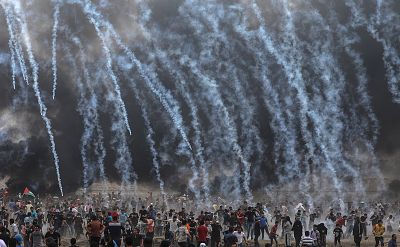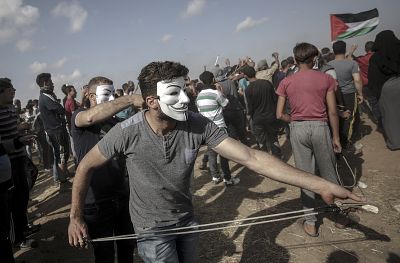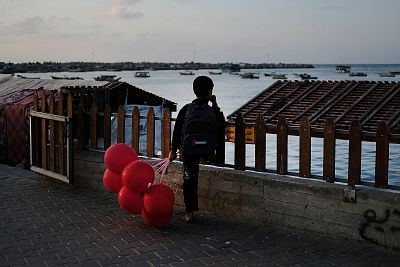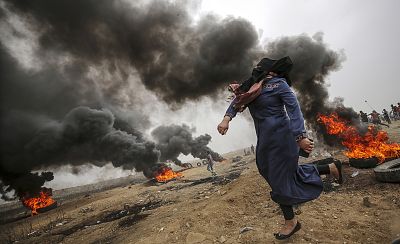Nearly 50 demonstrators have died and more than 9,500 have been wounded during protests since March 30, according to Gaza's Ministry of Health.
GAZA CITY, Gaza Strip — It started not with a bullet or a bomb, but with a hashtag.
"What if 200,000 demonstrators came out in a peaceful march and broke into the barbed wire east of Gaza," wrote Ahmed Abu Artema in a Facebook post on Jan. 7.
"What can a heavily-armed occupation do to those peaceful human waves?" the 32-year-old Palestinian journalist asked.
Artema ended the post with #GreatMarchofReturn — a slogan that quickly went viral and then, two months later, blossomed into reality.
On Monday and Tuesday, Artema's audacious "Great March of Return" will face what could be its most formidable and perhaps final test: an attempt by hundreds of thousands of protesters to breach the razor wire fence between the Gaza Strip and Israel.
Regardless of how Israel reacts to the planned waves of demonstrators, the protest movement spawned from Artema's Facebook post has defied much of the conventional wisdom about Gazan resistance to Israel's more than decade-long blockade. It has remained relatively peaceful, largely free from domination by powerful militant factions and inclusive of female activists.
"Everybody agrees that this is a kind of public struggle," Artema told NBC News as he strolled through clumps of men, women and children sitting on the ground and in tents near the fence separating the Gaza Strip from Israel on Friday, the seventh weekly demonstration since the protests began on March 30. "We are against any faction or party taking this march into their agenda."
Getting powerful groups to join — but not dominate — the movement took convincing, said Salah Abdel Ati, the head of the Great March of Return's International and Legal Committee.
Broad buy-in is part of the strategy. Organizers say the "Great March of Return" is financed by small donations and governed by a central committee of about 27 seats populated by representatives from some 18 political and civil society groups — including the dominant West Bank political party Fatah, as well as Hamas and Palestinian Islamic Jihad, both of which are recognized by the U.S. as terrorist organizations.
"Before we established this idea, Hamas didn't believe it," said Ati. "We discussed more and more with Hamas, Islamic Jihad, with all the parties."
From the looks of it, that cajoling has been successful. On Friday, there was a noticeable absence of Hamas or Islamic Jihad flags at a field near the barrier. Only Palestinian national flags were flown.
The movement's aims are equally broad: Monday's march is meant to protest the inauguration of the U.S. Embassy in Jerusalem, which Palestinians consider their capital. Tuesday is "Nakba" or Catastrophe Day, when Palestinians observe the 70th anniversary of Israel's founding.
But the ultimate goal — walking peacefully from Gaza into Israel — looks like a suicide mission.
Marchers say they have continued to turn out for the weekly demonstrations because they have so little to lose. More than a decade under Israeli and then Egyptian blockades has left the enclave's 2 million people, particularly its youth, largely jobless and hopeless.
In Gaza, fresh water is unsanitary and the seas are polluted with raw sewage. Power lasts as little as four hours a day while medical care and education are abysmal. Peace seems increasingly far off and, for most Gazans, gaining permission to leave is impossible without solid education or job opportunities abroad.
"The youth really struggle with a lack of prospects and hope of a good life," said recent graduate Anass Jnena, 23. "I have seen friends really weep in silence because they could not get to travel out."
The movement's explicit demand is what Palestinians refer to as their "right of return" — the demand that Israel allow the return of millions of Palestinians whose families left or were forcibly removed from Israel at its founding in 1948. Refugees and their descendants make up more than two-thirds of Gaza's population.
Decades of Israeli leaders have argued that allowing millions of Palestinians to return would diminish the Jewish state's foundational character.
But it was the Trump administration's decision to move the U.S. Embassy to Jerusalem that became the major motivating factor, according to organizers and participants.
"We felt that the American administration is working against the Palestinians in this issue," said Isam Hammad, 52, the regional manager of a medical equipment company who said he volunteered to help Artema the day he read his Facebook post. "We felt this all the time but not as clear as this."
Despite the march's high ideals, demonstrators have resorted to violence — throwing stones, rolling burning tires and lofting "incendiary kites" to ignite Israeli fields on the other side of the fence.
"I do understand why they throw stones," said Anas Inaina, 25, a project coordinator. "You do not throw flowers when you are just suffocating here."
But human rights groups have faulted Israel for answering rudimentary weapons with live ammunition. The Israeli Defense Forces have said the use of live ammunition was necessary to protect the border.
During the maiden demonstration on March 30, Israeli soldiers killed more than 20 protesters. Videos showed several being shot as they ran away.
Since then, nearly 50 have died and more than 9,500 have been wounded, according to Gaza's Ministry of Health. Several hundred injured protesters were children, according to Save the Children.
No Israelis have been killed or injured.
Keeping the protests peaceful is one of the organizers' principal challenges, particularly reining in desperate young men.
The presence of women and children has also had a calming influence — a novelty for Gaza resistance that Israeli officials have likened to the use of human shields. On Friday, women could be seen cooking and distributing food but also joining men on the front line.
"Women are taking places there and they are also welcome there and participating as equal as men," said Alorjwan Fhurrab, 23, a recent graduate who is unemployed.
When Fhurrab joined the march one Friday in April, she said she was forced to flee when Israeli snipers opened fire.
"I was running as fast as the young men ran!" she said, but added "some young men were telling me to run faster in order for me to be safe."
Organizers and rank-and-file activists hope the movement will remain a peaceful force beyond this week. But they also worry that a violent reaction from Israel could lead to an unmanageable situation — one that would once again push violent groups like Hamas and Islamic Jihad to the forefront.
"We believe we will continue," said Ati. "That's one scenario. The other scenario is if the Israelis kill more people, if there's a massacre … maybe we will go to war."















